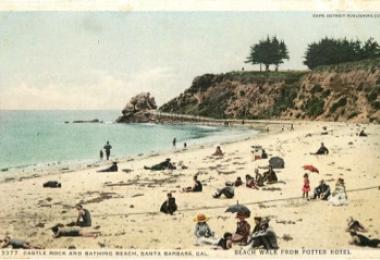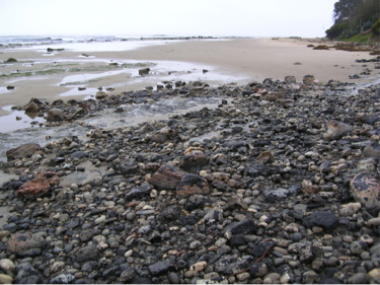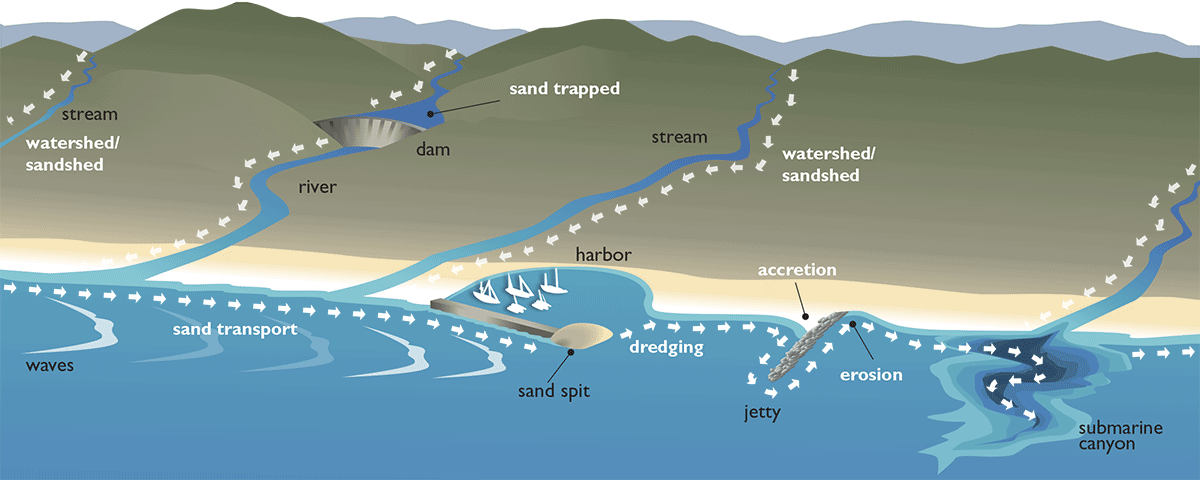Sandshed: The Sand Is on the Move!
There is a constant flow of sand from the land into the ocean. Watershed run-off and bluff and hillside erosion bring sand to the beach. Sand grains travel southward down the coast, while finer particles of sediment are carried and deposited further out to sea.
Along the way, sand is washed ashore, temporarily resting on beaches, until it is re-suspended in the ocean by wave action or wind. The one-way journey down the coast ends when sand is blown inland forming sand dunes, or more commonly, when it flows into a submarine canyon. This deep underwater feature is essentially the dead end of a littoral cell, where sand is deposited for the long-term and, for practical purposes, lost.
Littoral Cell
A littoral cell is a distinct area of the coastline where sand enters the ocean, flows down the coast, and then is removed from the system. Permanent loss of sand occurs at the end of the littoral cell when it flows into a submarine canyon or, less frequently, when it accumulates on shore as part of a sand dune. The amount of sand available to beaches is the amount of sand flowing into the littoral cell minus the amount flowing out. If this sand budget is altered, beaches can narrow or even disappear.
Seasonal Change
Southern California beaches undergo dramatic seasonal change due to a shift in wave energy. High-energy winter storm waves pull sand offshore, creating more narrow, cobbled beaches. Lower, gentle summer waves carry sand onshore, widening beaches.
Credit: From "Living with Coastal Change" website, Inman et al. 2003 at SIO. Animation produced by Earthguide with support from the Kavli Foundation.
Seasonal change is illustrated in two postcards below that depict the same Santa Barbara beach during summer and winter conditions in 1909 and 1910.


Our Beaches Are Starving!

It is notuncommon for Southern California beaches to be missing close to 50% of their historical sand supply. This sediment-starved condition is a result of human impacts to watersheds. Man-made structures such as dams, jetties and breakwaters (forms of coastal armoring) alter the natural flow of sand, which accumulates behind these structures causing erosion of beaches downstream. Urbanization of watersheds traps sediment under hardened surfaces so it no longer flows into the ocean with rainwater run-off. The result is reduced sand supply to beaches and, consequently, loss of beach habitat.
One example of a project aimed at restoring natural sediment supply is the Matilija Dam removal project in Ventura County.
Beach nourishment activities are commonly used to counteract reduced sediment supply and to widen beaches for recreational purposes. Find local examples of nourished and relatively unaltered Southern California beaches using an interactive map.
Quick Facts
- There is a constant flow of sand from the land into the ocean.
- Sand is washed ashore with waves and blown inland forming sand dunes.
- There are dramatic seasonal changes in sand movement: high-energy winter storm waves pull sand offshore; lower, gentle summer waves carry sand onto the beach.
- Sand flows into submarine canyons where it is stays for millennia (barring human intervention).



